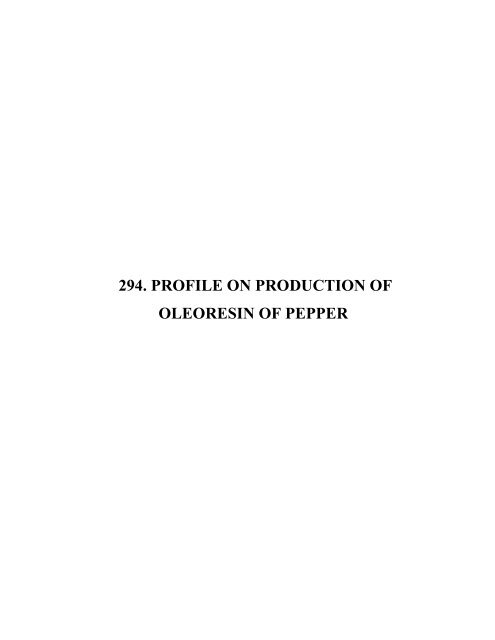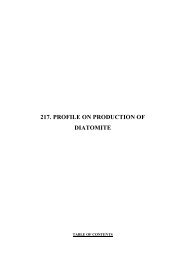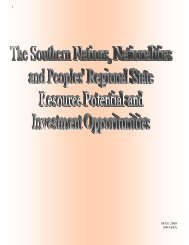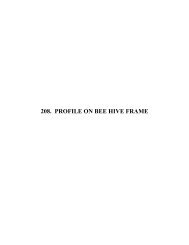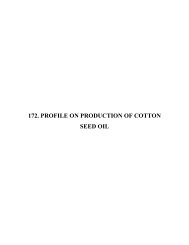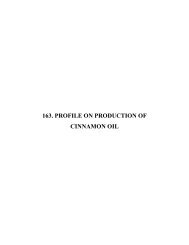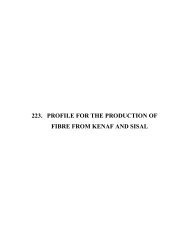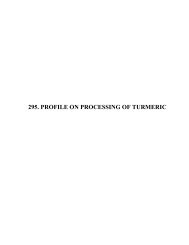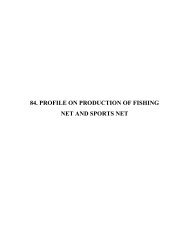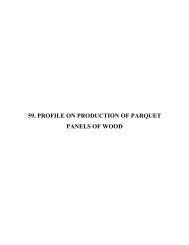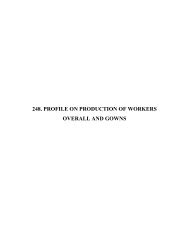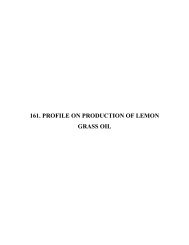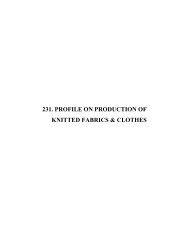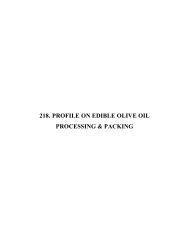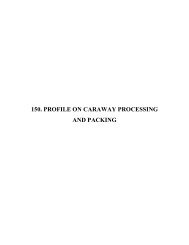294. PROFILE ON PRODUCTION OF OLEORESIN OF PEPPER
294. PROFILE ON PRODUCTION OF OLEORESIN OF PEPPER
294. PROFILE ON PRODUCTION OF OLEORESIN OF PEPPER
Create successful ePaper yourself
Turn your PDF publications into a flip-book with our unique Google optimized e-Paper software.
<strong>294.</strong> <strong>PR<strong>OF</strong>ILE</strong> <strong>ON</strong> PRODUCTI<strong>ON</strong> <strong>OF</strong><br />
<strong>OLEORESIN</strong> <strong>OF</strong> <strong>PEPPER</strong>
2<br />
TABLE <strong>OF</strong> C<strong>ON</strong>TENTS<br />
PAGE<br />
I. SUMMARY 294-3<br />
II. PRODUCT DESCRIPTI<strong>ON</strong> & APPLICATI<strong>ON</strong> 294-3<br />
III. MARKET STUDY AND PLANT CAPACITY 294-4<br />
A. MARKET STUDY 294-4<br />
B. PLANT CAPACITY & PRODUCTI<strong>ON</strong> PROGRAMME 294-7<br />
IV. MATERIALS AND INPUTS 294-8<br />
A. RAW & AUXILIARY MATERIALS 294-8<br />
B. UTILITIES 294-9<br />
V. TECHNOLOGY & ENGINEERING 294-9<br />
A. TECHNOLOGY 294-9<br />
B. ENGINEERING 294-11<br />
VI. MANPOWER & TRAINING REQUIREMENT 294-13<br />
A. MANPOWER REQUIREMENT 294-13<br />
B. TRAINING REQUIREMENT 294-15<br />
VII. FINANCIAL ANLYSIS 294-15<br />
A. TOTAL INITIAL INVESTMENT COST 294-15<br />
B. PRODUCTI<strong>ON</strong> COST 294-16<br />
C. FINANCIAL EVALUATI<strong>ON</strong> 294-17<br />
D. EC<strong>ON</strong>OMIC BENEFITS 294-18
3<br />
I. SUMMARY<br />
This profile envisages the establishment of a plant for the production of oleoresin of pepper<br />
with a capacity of 100 tonnes per annum.<br />
The present demand for the proposed product is estimated at 100 tonnes per annum. The<br />
demand is expected to reach at 307 tonnes by the year 2020.<br />
The plant will create employment opportunities for 35 persons.<br />
The total investment requirement is estimated at Birr 19.93 million, out of which Birr 10<br />
million is required for plant and machinery.<br />
The project is financially viable with an internal rate of return (IRR) of<br />
present value (NPV) of Birr 10.72 million ,discounted at 8.5%.<br />
22 % and a net<br />
II.<br />
PRODUCT DESCRIPTI<strong>ON</strong> AND APPLICATI<strong>ON</strong><br />
Oleoresin of Pepper (ORP) is a slightly viscous, homogenous red liquid with good flow<br />
properties at room temperature extracted from pepper Capsicum annuum (also from its<br />
variant, Paprika). It has non-pungent forms and also pungent hot forms. This oily substance is<br />
the concentration of pigments obtained through a solvent extraction process of pepper with<br />
hexane or super critical carbon dioxide. In production of oleoresin from pepper, the oleoresin<br />
is further treated with polar solvent, methanol, in order to separate the pungent component<br />
oleoresin capsicum from the colour component oleoresin paprika.<br />
Since the product is in liquid form (rather than in ground form, which has a lot of variances) it<br />
facilitates a more accurate application in the food and pharmaceutical industries, snack<br />
seasonings, sausage products, cheeses, soups and other foods where characteristic coloring<br />
and flavoring are desired. As compared to essential oils, oleoresins provide a more complete<br />
flavor profile than essential oils. Further advantages are the concentration at source of the
4<br />
product and the reduction in transport costs. Also essential is the minimizing of colour losses<br />
(capsanthin breakdown). The colour loss in paprika oleoresin is reduced to approximately 1-2<br />
% per year only as opposed to 2-4 % per month in compressed whole pods and up to 5 % per<br />
month in paprika powder. These colour losses are caused by oxidation and are greatly<br />
influenced by exposure to oxygen, light and heat.<br />
III.<br />
MARKET STUDY AND PLANT CAPACITY<br />
A. MARKET STUDY<br />
1. Supply and Present Demand<br />
In Ethiopia, there are two varieties of pepper, known as Mareko Fana and Bako Local.<br />
Mareko Fana is the most suitable for oleoresin extraction. Currently, there are two local<br />
producers of paprika oleoresin.<br />
During the period 2002 – 2006 on average 49.1 tones of the product was exported from<br />
Ethiopia .There was an increase in exports from year 2002 to 2003, as shown in Table 3.1.<br />
In 2004 another slight increase in exports was observed. However, in 2005 there was a<br />
decrease in exports and in 2006 there was no export. Decreasing exports is usually due to<br />
shortage of raw material.
5<br />
Table 3.1<br />
ETHIOPIAN EXPORTS <strong>OF</strong> PAPRIKA <strong>OLEORESIN</strong> (T<strong>ON</strong>NES)<br />
Year Export<br />
2002 20.5<br />
2003 60<br />
2004 67.3<br />
2005 48.6<br />
2006 -<br />
Average 49.1<br />
In the international market the export of oleoresins grew an average 9 percent per year during<br />
the period 2000 - 2005, reaching a value of USD 237 million. The largest players in the world<br />
market are Brazil (17 percent share), India (17 percent) and the USA (14 percent). Whereas<br />
India has shown significant growth during the last 5 years, the USA and the UK have their<br />
seen exports decline in the same period. Major African exporters are Morocco (USD 6<br />
million), South Africa (USD 4 million) and Zimbabwe (USD 1 million).<br />
Brazil, India and the USA are the main exporting countries of paprika oleoresins at a global<br />
level.<br />
Accordingly, considering the huge international market potential of the product the current<br />
effective export demand for the product is estimated at about 100 tonnes.<br />
2. Projected Demand<br />
The world demand for paprika oleoresin is increasing. As indicated earlier in the international<br />
market the export of oleoresins grew an average 9 percent per year during the period 2000 –<br />
2005. Accordingly this growth rate is considered in projecting the demand for the product.
6<br />
Table 3.2<br />
PROJECTED DEMAND(T<strong>ON</strong>NES)<br />
Year Projected Demand<br />
2008 109<br />
2009 119<br />
2010 130<br />
2011 141<br />
2012 154<br />
2013 168<br />
2014 183<br />
2015 199<br />
2016 217<br />
2017 237<br />
2018 258<br />
2019 281<br />
2020 307<br />
3. Pricing and Distribution<br />
Pricing of the product is usually negotiated every time for every new order. On the basis of<br />
the negotiation the price is agreed for that particular order. However, for the purpose of<br />
financial analyses the current price of the product, i..e ,Birr 35 USD per kg is adopted.<br />
The product is packed in 50 or 200 kg drums, according to the preference of the buyer. The<br />
drums are imported from abroad and are food grade type. Then the packed materials are<br />
transported from the factory to the airport. Since the materials are low volume and high value,<br />
they are exported by plane directly to end -users.
7<br />
B. PLANT CAPACITY AND PRODUCTI<strong>ON</strong> PROGRAMME<br />
1. Plant Capacity<br />
The proposed annual processing capacity of the envisaged plant is 100 tonnes of oleoresin<br />
taking in to account that high capital costs associated with extraction plants and constraints<br />
with raw material supply. This capacity will be attained by working single shift a day having<br />
eight working hours and 300 working days per annum. In this study, the size of the resin lined<br />
steel drum used to pack the product is assumed to be 50 kg and 200 kg, according to the<br />
buyers’ preference. It is assumed that the 50 kg size is more popular than the 200 kg;<br />
therefore, 60% of the total production shall be packaged in 50 kg and the balance in 200 kg.<br />
2. Production Programme<br />
The annual production programme is formulated on the basis of the market forecast, selected<br />
plant capacity and time required for gradual build-up in labour productivity and fine-tuning of<br />
machinery. Therefore, it is assumed that the plant will achieve 75% and 85% capacity<br />
utilization rate in the first and second years, respectively. Full capacity will be reached in the<br />
third year and onwards. The envisaged production programme is shown in Table 3. 3.<br />
Table 3. 3<br />
ANNUAL PRODUCTI<strong>ON</strong> PROGRAMME<br />
Sr.<br />
Production Year<br />
Unit<br />
No Description<br />
2008 2009 2010-2020<br />
1. In 50 kg drum Tones 45 51 60<br />
2. In 200 kg drum Tones 30 34 40<br />
Total Tones 75 85 100<br />
3. Capacity utilization rate % 75 85 100
8<br />
IV.<br />
MATERIALS AND INPUTS<br />
A. RAW AND AUXILIARY MATERIALS<br />
The Principal raw materials required for the envisaged plant is pepper which is produced<br />
locally in the region. Pepper raw materials costs make up 80 percent of the total costs for<br />
oleoresin production. The types of solvent used in the production process are totally imported<br />
from abroad and represent 10 percent of the total costs.<br />
The major auxiliary materials required by the plant basically constitute solvents and packing<br />
materials, i.e. resin lined steel drums of 50 and 200 kg capacity. Both are assumed to be<br />
imported from abroad. Label in required size and desired number of colours print can be<br />
locally available from the public or private enterprises. Carbon dioxide, is supposed to be<br />
produced on-site.<br />
The annual requirement (at full capacity) of raw & auxiliary materials and their estimated<br />
costs is indicated in Table 4.1.<br />
Table 4.1<br />
ANNUAL RAW AND AUXILIARY MATERIALS REQUIREMENT AND COST<br />
Annual<br />
Sr.<br />
Unit Price Total Cost<br />
Description<br />
Unit Requirement<br />
No<br />
(Birr) (‘000 Birr)<br />
1 Pepper (Capsicum Annum ) Tonne 1,000 25,000 25,000<br />
2 Resin lined steel drum (50 kg) Pcs 1,200 40 48<br />
3 Resin lined steel drum (200 kg) Pcs 200 100 20<br />
4 Label Pcs 1,680 128 215<br />
Grand Total 25,268 25,283
9<br />
B. UTILITIES<br />
The major utilities required by the plant are electricity, lubricants and water for general<br />
purpose. Table 4.2 below shows annual requirement and associated cost at full production<br />
capacity.<br />
Table 4.2<br />
ANNUAL UTILI IES REQUIREMENT AND COST<br />
Sr.<br />
Annual Requir- Unit Cost Total Cost<br />
Description Unit<br />
No<br />
ement (Birr) ( Birr)<br />
1. Electricity KWh 110,000 0.4736 52,096<br />
2. Lubricants Lit 130 56 7,280<br />
3. Water M 3 1,800 5.5 9,900<br />
Total Cost 69,276<br />
V. TECHNOLOGY AND ENGINEERING<br />
A. TECHNOLOGY<br />
1. Production Process<br />
The extraction process used here is the Supercritical Fluid Extraction (SFE) method, which<br />
makes use of carbon dioxide as solvent. This technology is state-of-the-art and globally<br />
proven. Moreover, it is environmentally friendly as compared to the conventional method<br />
which is based on hexane- an organic solvent. The market price for the product obtained<br />
through this process is much higher as compared to the product obtained from the<br />
conventional method, as the former do not contain any chemical residues and the purity level<br />
is very high.<br />
The manufacturing process involves the following operations:
10<br />
Grinding:- Before transporting the raw material to the extractor machine, it has to pass some<br />
post extraction operations:<br />
- The dry raw material is at first reduced in size by pin mills, hammer mills and sized in the<br />
grinding section;<br />
- Then the raw material is ground through a process known as Cryogenic Grinding in which<br />
temperature of the material is lowered to its embrittlement point, using liquid CO2.<br />
Extraction: - This process is a rapid production of concentrated pigments through a solvent<br />
extraction process of pepper with super critical carbon dioxide.<br />
• Liquid carbon dioxide from the plant storage tank is transferred to the day tank of about<br />
2000 liters capacity at 60 bar pressure through a reciprocating pump;<br />
• The liquid carbon dioxide coming out of the pump is heated up to the required<br />
temperature of extraction at 60-70 degree centigrade and is admitted into the extractor;<br />
• Ground pepper is loaded into the extractor through a removable basket with perforated<br />
disks at the bottom and top to allow the liquid / gaseous CO 2 to pass through the ground<br />
pepper;<br />
• Super critical CO 2 absorbs the food materials to be extracted and oils and oleoresins flow<br />
out of the extractor;<br />
• Before it enters the separators, the pressure is dropped to a certain level wherein the<br />
oleoresins portion is separated in the first separator; on further drop in pressure, the<br />
essential oils are separated in the second separator;<br />
• The residual CO 2 coming out of the second separator is condensed in the condenser and<br />
returns back to the day tank for recycling. This process continues till the essential oils and<br />
oleoresins are extracted completely.<br />
Packaging: - After proper treatment, the resin lined steel drums are automatically conveyed<br />
to the filling and capping rotors. After labeling and sealing, the drums are transferred to the<br />
discharge conveyor.
11<br />
2. Source of Technology<br />
The machinery and equipment required for production of oleoresin from pepper could be<br />
obtained from the following companies:<br />
1. Natex Prozesstechnologie GesmbH<br />
Hauptstrasse 2,<br />
A-2630 Ternitz, Austria<br />
Tel: +43/2630/32120,<br />
Fax: +43/2630/38163<br />
Mail: office@natex.at<br />
2. M V Industries Pvt. Ltd.,<br />
Raja S C Mullick Road, Bademasur<br />
Calcutta 86, India.<br />
B. ENGINEERING<br />
1. Machinery and Equipment<br />
The list of machinery and equipment required for the manufacture of oleoresins is given in<br />
Table 5.1. The total cost of machinery and equipment for the envisaged annual output is<br />
estimated at Birr 10 million, out of which Birr 7 million is required in foreign currency.
12<br />
Table 5.1<br />
LIST <strong>OF</strong> MACHINERY AND EQUIPMENT<br />
Sr.<br />
No.<br />
Description Unit Qty.<br />
1 Destoner Pc 1<br />
2 Huller Pc 1<br />
3 Pulverizer Pc 1<br />
4 Extractor Pc 1<br />
5 Separator Pc 1<br />
6 Circulation pump Set 1<br />
7 Pre-heater Set 1<br />
8 Measuring & controlling system Set 1<br />
9 CO 2 plant & tanks Pc 1<br />
10 Condenser Pc 1<br />
11 Cooling unit Pc 1<br />
12 Compressor Set 1<br />
13 Lab equipment Set 1<br />
14 Auxiliary equipment Set 1<br />
2. Land, Building and Civil Works<br />
The total land area of the plant including both open and built-up area is about 4,000m 2 . Total<br />
built-up area including factory building, office, storage for raw materials and finished<br />
products is estimated to be 1,500m 2 . Payment to land holdings for 80 years is estimated at<br />
Birr 32,000 at a lease rate of Birr 0.1 per m 2 per annum.<br />
Cost of building construction, at a unit cost of Birr 2,300 per m 2 , is estimated at Birr 3.45<br />
million. Thus, the total investment cost for land, buildings and civil works assuming that the<br />
total land lease cost will be paid in advance is estimated at Birr 3.482 million.
13<br />
3. Proposed Location<br />
Though proximity to the market is also an important factor in order to minimize transportation<br />
and distribution costs, the envisaged plant is proposed to be located in area where abundant<br />
raw material (red pepper) is available. Taking this in to consideration, Mareko, Dalocha,<br />
Sankura and Shashongo woredas which are found in Guraghe, Silte, and Hadiya zones<br />
respectively can be the possible locations for the project.<br />
From the above possible locations, Mareko Town, the capital of Mareko woreda, is selected to<br />
be the location of the proposed project as it is the major growing area for the Mareko Fana<br />
type of pepper. It is also believed that commercial paprika plantations could be established<br />
there.<br />
VI.<br />
MANPOWER AND TRAINING REQUIREMENTS<br />
A. MANPOWER REQUIREMENT<br />
The total manpower required, including skilled and unskilled labor, is 35 persons.<br />
Corresponding total annual labor cost, including fringe benefits, is estimated at Birr 367,500.<br />
Table 6.1 shows the list of manpower required and the estimated annual labor cost.
14<br />
Table 6.1<br />
MANPOWER REQUIREMENT AND ANNUAL LABOR COST<br />
Sr.<br />
No.<br />
Description<br />
Req.<br />
No.<br />
Monthly<br />
Salary<br />
[Birr]<br />
Annual<br />
Salary<br />
[Birr]<br />
1. General Manager 1 2,500 30,000<br />
2. Production & Technical Manager 1 2,000 24,000<br />
3. Finance & Administration Manager 1 1,800 21,600<br />
4. Commercial Manager 1 1,800 21,600<br />
5. Accountant 1 750 9,000<br />
6. Sales person 1 750 9,000<br />
7. Purchaser 1 600 7,200<br />
8. Clerk 3 1,050 12,600<br />
9. Secretary 2 1,200 14,400<br />
10 Quality Control Manager 1 1,800 21,600<br />
11 Production Foreman 3 2,400 28,800<br />
12 Chemist 2 1,600 19,200<br />
13 Operator 4 2,000 24,000<br />
14 Mechanic 1 700 8,400<br />
15 Electrician 1 700 8,400<br />
16 Unskilled labor 6 1,200 14,400<br />
17 Guard 3 750 9,000<br />
18 Diver 2 900 10,800<br />
Total 35 24,500 294,000<br />
Worker’s Benefit = 25% of Basic Salary 6,125 73,500<br />
Grand Total 30,625 367,500
15<br />
B. TRAINING REQUIREMENT<br />
An on-site training programme can be arranged for key production, maintenance and quality<br />
control personnel in consultation with the machinery and technology supplier. The training<br />
can be best carried out during commissioning and performance testing of the factory. Cost of<br />
an on-site training of this nature is estimated at Birr 75,000.<br />
VII. FINANCIAL ANALYSIS<br />
The financial analysis of the oleoresin of pepper project is based on the data presented in the<br />
previous chapters and the following assumptions:-<br />
Construction period<br />
1 year<br />
Source of finance<br />
30 % equity<br />
70 % loan<br />
Tax holidays<br />
5 years<br />
Bank interest 8%<br />
Discount cash flow 8.5%<br />
Accounts receivable<br />
30 days<br />
Raw material local<br />
30days<br />
Work in progress<br />
5 days<br />
Finished products<br />
30 days<br />
Cash in hand<br />
1 days<br />
Accounts payable<br />
30 days<br />
A. TOTAL INITIAL INVESTMENT COST<br />
The total investment cost of the project including working capital is estimated at Birr 19.93<br />
million, of which 31 per cent will be required in foreign currency.<br />
The major breakdown of the total initial investment cost is shown in Table 7.1.
16<br />
Table 7.1<br />
INITIAL INVESTMENT COST<br />
Sr.<br />
No.<br />
Cost Items<br />
Total Cost<br />
(‘000 Birr)<br />
1 Land lease value 32<br />
2 Building and Civil Work 3,450.00<br />
3 Plant Machinery and Equipment 10,000.00<br />
4 Office Furniture and Equipment 125<br />
5 Vehicle 650<br />
6 Pre-production Expenditure* 1,032.29<br />
7 Working Capital 4647.06<br />
Total Investment cost 19,936.4<br />
Foreign Share 31<br />
* N.B Pre-production expenditure includes interest during construction ( Birr 882.29<br />
thousand ) training (Birr 75 thousand ) and Birr 75 thousand costs of registration,<br />
licensing and formation of the company including legal fees, commissioning expenses, etc.<br />
B. PRODUCTI<strong>ON</strong> COST<br />
The annual production cost at full operation capacity is estimated at Birr 28.20 million (see<br />
Table 7.2). The material and utility cost accounts for 89.89 per cent, while repair and<br />
maintenance take 0.89 per cent of the production cost.
17<br />
Table 7.2<br />
ANNUAL PRODUCTI<strong>ON</strong> COST AT FULL CAPACITY ('000 BIRR)<br />
Items Cost %<br />
Raw Material and Inputs<br />
25,283.00 89.65<br />
Utilities<br />
69.28 0.25<br />
Maintenance and repair<br />
250 0.89<br />
Labour direct<br />
217.35 0.77<br />
Factory overheads<br />
72.45 0.26<br />
Administration Costs<br />
144.9 0.51<br />
Total Operating Costs<br />
26,036.98 92.32<br />
Depreciation<br />
1345 4.77<br />
Cost of Finance<br />
821.2 2.91<br />
Total Production Cost 28,203.18 100<br />
C. FINANCIAL EVALUATI<strong>ON</strong><br />
1. Profitability<br />
According to the projected income statement, the project will start generating profit in the<br />
first year of operation. Important ratios such as profit to total sales, net profit to equity<br />
(Return on equity) and net profit plus interest on total investment (return on total investment)<br />
show an increasing trend during the life-time of the project.<br />
The income statement and the other indicators of profitability show that the project is viable.
18<br />
2. Break-even Analysis<br />
The break-even point of the project including cost of finance when it starts to operate at full<br />
capacity ( year 3) is estimated by using income statement projection.<br />
BE = Fixed Cost = 25 %<br />
Sales – Variable Cost<br />
3. Pay Back Period<br />
The investment cost and income statement projection are used to project the pay-back period.<br />
The project’s initial investment will be fully recovered within 5 years.<br />
4. Internal Rate of Return and Net Present Value<br />
Based on the cash flow statement, the calculated IRR of the project is 22 % and the net<br />
present value at 8.5% discount rate is Birr 10.72 million.<br />
D. EC<strong>ON</strong>OMIC BENEFITS<br />
The project can create employment for 35 persons. In addition to supply of the domestic<br />
needs, the project will generate Birr 8.11 million in terms of tax revenue.


